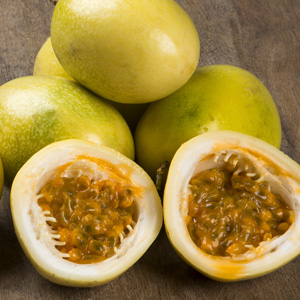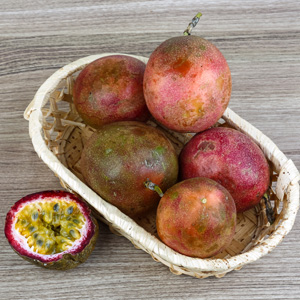Passionfruit Growing Guide

What is Passionfruit?
Passionfruit (Passiflora edulis) is an evergreen perennial fruiting vine. It is part of the Passifloraceae family and is native to South America. There are more than 50 varieties of Passionfruit vines which are suited for temperature to tropical climates. Hybrids have been bred that are suited for cooler climates and tolerate light frost such as ‘Nellie Kelly’. Passionfruit is a self-fertile plant which allows you to only need one plant to produce fruit. They are a rapid growing, evergreen vine which supports itself with tendrils. It has glossy, bright to dark green leaves. Passionfruit vines flower in Spring with mostly purple and white starry blooms. Flowers are followed by the fruit which is green that will mature into their colour depending on the variety. Fruit colour is usually purple however other varieties can be yellowy brown or red. The Passionfruit plant needs time to mature in the ground before it will flower and fruit. In the subtropics they may begin fruiting in 6 to 12 months from planting, but in most parts of temperate Australia it takes 18 months before flowering begins and fruit forms. Passionfruit’s need to fully ripen on the vine and will drop off when they’re ready to eat. Gather fallen fruit every day in Summer so they do not burn. They should be planted in a full sun position that is protected from the strong wind. The Passionfruit plant needs something to climb on such as a fence or pergola, wires or wire netting. They are a hungry and thirsty plant that needs a well drained soil. Keep the surrounding area free of weeds and competing plants, including grass.
Benefits of Growing Passionfruit
Passionfruit vines can be used as a screening plant or shade an area as the vine climbs over fences and trellises. The wrinkled fruit contains vitamins A and C, potassium and iron, and is good for salads, desserts and in drinks. The Passionfruit pulp can be bottled, made into sauce or eaten fresh. The plant attracts bees and butterflies when flowering.
How to Grow Passionfruit
Climatic Zones
Passionfruit thrive in subtropical and temperate regions. There have been many hybrids produced that are suited for cooler areas of Australia capable of dealing with light frosts.
Plant Size
Sizes vary.
Passionfruit Nellie Kellie Height: 4.5m, Width: 2-4m
Passionfruit Panama Red Height: 4.5m, Width: 2-3m
When To Plant Passionfruit
Plant in Spring.
Soil Preparation
Passionfruit plants like a well drained fertile soil for good fruit production. Dig through compost and chicken manure into the soil before planting. Dig a hole twice as wide and just as deep as the root ball.
How To Plant Passionfruit
Plant in full sun, with the plant crown at soil level.
Passionfruit Plant Care
Passionfruit requires regular watering, as their roots are shallow. Especially make sure adequate watering is given during growing and fruiting times and during Summer.
Mulch annually to retain moisture in the soil, suppress weeds and to keep the shallow roots cool and protected. Keep the mulch away from the stems to avoid collar rot.
Apply a complete fertiliser in Spring when new growth starts and follow up with light top dressings of a complete fertiliser every 3 – 4 weeks through Summer. (It is very difficult to over fertilise a Passionfruit). You can also top dress with chicken manure twice a year, in Spring and Autumn.
Leave the vine to climb in its first year, then pinch out the top bud to encourage lots of side shoots. Cut vines back after fruiting if too dense to encourage new laterals and more fruit.
Check regularly for suckers growing below the graft line and remove immediately. You’ll know if you have suckers growing from the understock as its leaves, flowers and fruit are very different from your normal plant.
Can be susceptible to fungal problems if conditions are too cold and wet. They can also suffer from the usual sucking insects that attack fruiting plants.
Sometimes the Passionfruit might not flower or fruit. This could be because of poor pollination which is the most common cause.










